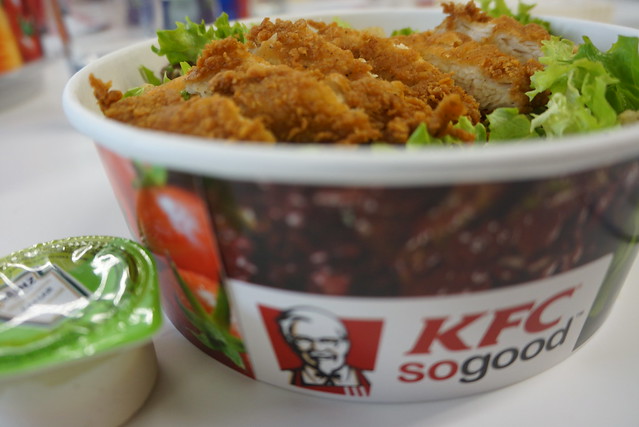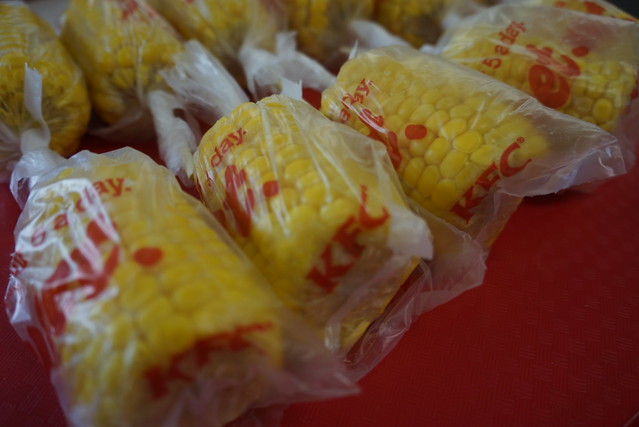Here’s another piece to add to my bucket o’ posts about my recent “behind the scenes” visit to KFC HQ in Woking.
My day there kicked off with a brief intro led by Mark Baxter, Operation Innovation Manager for KFC UK & Ireland. Mark’s honesty about where KFC stands on certain issues impressed me as did his headfirst dive into a discussion about animal welfare and nutrition. Although, I was left hanging with a few questions I asked and wondering if KFC could be doing at least a little bit more to promote better welfare for the birds they use and considerably more with respect to offering more nutritious and less ‘junky’ menu items.
For me, the takeaway was this: the chicken you eat at KFC is to the same standard or above that which you get from a typical high street supermarket and probably a lot better than anything from one of the myriad copycat skanky chicken joints spread across the UK. All KFC’s on-the-bone chicken is Red Tractor certified and from British farms. KFC was the first fast food retailer to get this sort of “seal of approval” for the quality of its product. More than 75% of all KFC chickens are raised in a “natural enrichment” environment. Basically, this means they have access to natural light and live in a setting that’s designed to minimise stress for the animal. I saw a video shot at a British farm supplying KFC with poultry. Obviously the clip highlighted the positive qualities of the conditions where the chickens live. Still it showed what looked to me like plenty of room for the birds to move about with some freedom. I was expecting it to be worse than what I viewed. By the middle of next year, all KFC-bought chickens will be “NE” raised. All animals slaughtered for KFC are stunned before being killed. Filets and other de-boned meat come from farms in Brazil and Thailand. I saw a vid from a Thai farm too. It looked even nicer than the British one. Some of the meat served at KFC is organic and some is halal (there are around 90 fully halal KFCs in the UK).
That’s all well and good. But when I enquired about the possibility of going free range, Mark explained that there just isn’t enough free range chicken out there to be purchased and that if KFC sold free range chicken the prices charged to customers would end up being a lot higher. He also said that “frankly we don’t think that most of our customers really care.” Now, I’m not going to claim to be a perfect saint, but I make an effort to buy meat from high welfare sources and really try to see meat as a treat and as something that you shouldn’t eat all the time just because it’s cheap and readily available. And sure, I’m a firm believer in the Law of Supply and Demand. Still, I thought his comment was a cop out and a slippery slope of an argument too.
Mark had a similar response to some questions I had about nutrition and added ingredients like sugar, dextrose and such. Essentially, I was trying to get at what a person is taking into his or her body (minus those top secret “11 herbs and spices” of course) when eating KFC products. Mark said most people who go to KFC wouldn’t want to known, but that he was sure if someone did they could find out. However, he didn’t tell me or point me in the right direction when I asked. He was able to tell me that there are no artificial transfats in any KFC dish and that the restaurants’ food is 98% palm oil free with the vast majority of fried items being cooked in a sunflower/rapeseed oil blend. There are healthy-ish options available too. In particular the “KFC Supersweet Corn Cobette” which launched this February is simply a steamed ear of corn with nothing added to do. I had one. It was tasty. Stay tuned for more in this series.
























Great post Chris!
I’m surprised and in awe of how transparent KFC has been in inviting you along to a open day. It’s reassuring that they source good quality farms for rearing chicken. Honesty, I never gave it much thought before and had them labelled in the same category as indy fried chicken peddlars.
I’m probably more likely to buy KFC now that I’ve read your blog.
Also, the corn cob sounds like my kinda thing.
Rax
Oh wow, Rax. Thanks. I certainly hope this series doesn’t read like I’m advocating KFC or anything. But, yeah, I was impressed with how open the reps there were. I think from the KFC side of things, there’s a feeling that they’ve done a lot to improve their standards – and that much of the negative buzz around the brand wasn’t even based on fact. My takeaway was that KFC is no worse than the ‘rest of the lot’ and in some case a better option than its direct competition. But I also thing the restaurant group has a long way to go.
Really appreciate you reading the blog and taking the time to comment!
Chris
Pingback: KFC Me: Clucking Off
Pingback: KFC Me: Fry Time